George Caleb Bingham had the good fortune to come of age as a man and an artist on the edge of the burgeoning West.
This combination of a young man’s restlessness in the midst of a growing nation offered Bingham a unique perspective on The Ideal for which his growing nation was striving.
And when young America showed itself to be less than ideal — often full of death, brutality and violence — Bingham’s youthful sense of hope for his country led him to create paintings that worked to remind America of its promise.
Being young and talented, he was able to combine a young person’s idealism with an artist’s deft eye, effectively making him an important witness as his young country grew from its own adolescence into adulthood.
This fortune of time and place allowed Bingham to capture both the daily concerns of the average man, woman and child alongside the sweeping issues of the day in this unsettled country.
Cottage Scenery, 1845. Courtesy Corcoran Gallery of Art.
Like the country he loved, Bingham was defined by restlessness. For proof look no further than his choice of a career as a portrait painter at time when day-to-day survival was often a struggle.
Choosing to be a fine artist can be considered reckless in any time or place, but who in their right mind chooses to be an artist when everyone — not just struggling artists — is one bad harvest away from the threat of starvation?
Bingham’s youth and restlessness would serve him well from the very beginning. Early in his art career he was self-taught, and it speaks to his natural talent and keen eye that much of the art he created during this early period is considered among his finest work.
The Verdict of The People, 1854. Courtesy St. Louis Museum of Art.
Growing up in his time and place gave him the opportunity to be one of just a handful of artists to capture America as it came of age. He helped shape the image of itself then and created a record that brings alive those 19th century hopes for 21st century viewers.
As Walt Whitman did with words, so Bingham did with his brush, wielding it to capture the glory of America whenever he recognized it. When his country fell short of its promise, Bingham was capable of using his art to re-affirm that promise, as if to remind his country of its potential.
But there is a depth even beyond that in his work. Bingham was no mere jingoist. He was a heartfelt artist whose work conveys much of the dramatic irony in the unfolding story of America.
Look closely at his work and you see that even when he’s showing The Ideal, he admits to the cracks beneath the surface of his beloved country. In his paintings there is often chaos at the edges or just out of the frame, discontent looming somewhere over the horizon.
The young do crazy things. This is as true of young nations as it is of young men and women. Fortunately, Bingham was there with his eye and his brush to capture it for us all.
To learn more about Bingham and for updates about the documentary, The American Artist: The Life & Times of George Caleb Bingham, due in 2016, please join our mail list.



